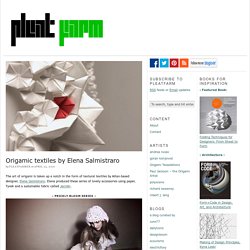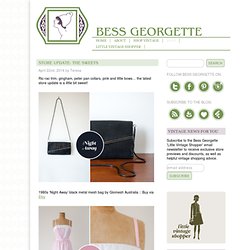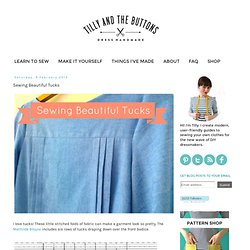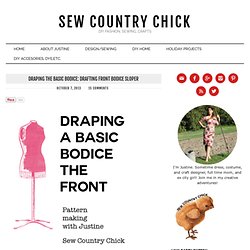

Origamic textiles by Elena Salmistraro. The art of origami is taken up a notch in the form of textural textiles by Milan-based designer, Elena Salmistraro.

Elena produced these series of lovely accessories using paper, Tyvek and a sustainable fabric called Jacroki. – Prickly Bloom Series – While teaming up with deepdesign‘s Raffaella Mangiarotti and Matthew Bazzicalupo, Elena created textural and prickly textiles for series of headwear and a neckpiece. Each accessory was produced by repeated elementary folds using both paper and Tyvek – a paper-like water-resistant fabric. Together with deepdesign, Elena utilized Tyvek to create this ornamental headwear functions as a hat, necklace and earrings. – Jacroki Bodice – Elena pursued her foldings further in the form of a bodice made of Jacroki: a type of sustainable fabric made from natural fibers and recycled paper fibers manufactured by Okinawa and designed by Michael Ruffin. – Origami Vase Cover in Jacroki-
Vintage fashion for modern times. It’s been a little while between bakes for me, but last weekend the baking drought ended!

My new place has a rather old oven and while I do love vintage things I was a little nervous to see how this ‘vintage’ piece would perform. Although… you’d think a vintage oven coupled with my vintage baking recipes will be a match made in heaven… right? Anyhoo… here’s how it went. The recipe I used was a simple and quick butter cake from the recipe book that came with my vintage Sunbeam Mixmaster.
Butter Cake Ingredients: 1/2 cup butter; flavouring (I used a bit of vanilla essence); 1/2 cup castor sugar; 2 eggs (I used a couple of duck eggs, which a friend from work gave me); 2 cups SR flour; 6 tablespoons milk. Beat the butter and flavouring in a large bowl until very soft. I iced my cake with a citrus frosting: Ingredients: 2 tspns grated lemon rind; 2 tblspns butter; 1 cup icing sugar.
Beat butter and rind until soft. Delicious! Sewing Beautiful Tucks. I love tucks!

These little stitched folds of fabric can make a garment look so pretty. The Mathilde Blouse includes six rows of tucks draping down over the front bodice. Tucks are constructed by stitching and pressing excess fabric to form folds. The pattern lines can seem a little confusing the first time you make tucks, but it’ll all make sense once you’ve done it once. Basically a tuck is formed as follows: - The central line of each tuck ("tuck fold line") is folded, wrong sides together, to bring the excess fabric up. - This brings the outer lines ("tuck stitching line") of the tuck together – these lines can then be sewn together They’re not the easiest thing to get right first time, so if you haven't made them before it's worth practising on some spare fabric before taking the plunge on your garment.
Here's the method I like to use: 1) Before you start sewing, mark the tuck lines onto the right side of the fabric. 4) Press the tucks flat. Don’t those tucks look awesome?! The Cutting Class. Sewing with the Bobbin Thread. Oh You Crafty Gal. Learn Textile Technology outside of classroom. Sewing Classes - Free Sewing Classes Index. Fashion, Sewing Patterns, Inspiration, Community, and Learning. Service. T.I.A: TAILORING. Sewing tips, ideas, and peeks into the Colette Patterns studio. The Cutting Class. Draping The Basic Bodice: Drafting Front Bodice Sloper. Hello readers!

I have been wanting to do a tutorial series on basic pattern draping and drafting for some time now. There is a lot of information involved and I wasn’t sure how to break it all down and it seemed like such a big job. But needed. So today I present to you: What is a sloper if you don’t already know? First I’d like to tell you a little bit about my background in pattern making, and how I originally learned to make them.
When I went to FIDM to study fashion design in the early nineties there were some very good teachers who came from a time when things were still made beautifully, with lots of attention to construction details. One of my intructors: Connie Amaden Crawford. Ms. My draping teacher was actually an elderly gentleman who always wore a suit and a pocket square with beautiful brushed back silver hair. I’ve been going through many of my old notes I found and textbooks to try to put something together I can present to you as a tutorial here on the blog. Let’s get started! Elise bergman.